In Situ FIB-TEM-TOF-SIMS Combination Technique: Application in the Analysis of Ultra-Light and Trace Elements in Phyllosilicates
Abstract
:1. Introduction
2. Experimental
2.1. Samples
2.2. Instrumentation and Operating Condition
3. Results and Discussion
4. Conclusions
Author Contributions
Funding
Conflicts of Interest
References
- Veblen, D.R.; Buseck, P.R. Serpentine minerals: Intergrowths and new combination structures. Science 1979, 206, 1398–1400. [Google Scholar] [CrossRef] [PubMed]
- Grim, R.E. Crystal structures of clay minerals and their X-ray identification. Earth-Sci. Rev. 1982, 18, 84–85. [Google Scholar] [CrossRef]
- Webb, P.C.; Potts, P.J.; Watson, J.S. Determination of rubidium and strontium in silicate rocks by energy dispersive and wavelength dispersive X-ray fluorescence analysis: A comparative evaluation of precision. J. Anal. At. Spectrom. 1993, 8, 293–298. [Google Scholar] [CrossRef]
- Voegelin, A.; Weber, F.-A.; Kretzschmar, R. Distribution and speciation of arsenic around roots in a contaminated riparian floodplain soil: Micro-XRF element mapping and EXAFS spectroscopy. Geochim. Cosmochim. Acta 2007, 71, 5804–5820. [Google Scholar] [CrossRef]
- Castillo, S.; Moreno, T.; Querol, X.; Alastuey, A.; Cuevas, E.; Herrmann, L.; Mounkaila, M.; Gibbons, W. Trace element variation in size-fractionated African desert dusts. J. Arid Environ. 2008, 72, 1034–1045. [Google Scholar] [CrossRef]
- Tóth, E.; Weiszburg, T.G.; Jeffries, T.; Williams, C.T.; Bartha, A.; Bertalan, É.; Cora, I. Submicroscopic accessory minerals overprinting clay mineral REE patterns (celadonite–glauconite group examples). Chem. Geol. 2010, 269, 312–328. [Google Scholar] [CrossRef]
- Ndzana, G.M.; Huang, L.; Zhang, Z.; Zhu, J.; Liu, F.; Bhattacharyya, R. The transformation of clay minerals in the particle size fractions of two soils from different latitude in China. Catena 2019, 175, 317–328. [Google Scholar] [CrossRef]
- Hadi, J.; Wersin, P.; Serneels, V.; Greneche, J.-M. Eighteen years of steel–bentonite interaction in the FEBEX in situ test at the Grimsel Test Site in Switzerland. Clays Clay Miner. 2019, 67, 111–131. [Google Scholar] [CrossRef] [Green Version]
- Dill, H.G.; Kaufhold, S.; Weber, B.; Gerdes, A. Clay Mineralogy and LA–ICP–MS dating of supergene U-Cu nontronite-bearing mineralization at Nabburg-Wolsendogf, Southeastern Germany. Can. Mineral. 2010, 48, 497–511. [Google Scholar] [CrossRef]
- Zhu, L.; Yang, Y.; Gu, H.; Wen, H.; Du, S.; Luo, C. Mineralogical Characteristics of Two Clay-type Lithium Resources in Yuxi, China, and Nevada, the United States of America. Rock Min. Anal. 2021, 40, 532–541. [Google Scholar] [CrossRef]
- Viets, J.; O’Leary, R. The role of atomic absorption spectrometry in geochemical exploration. J. Geochem. Explor. 1992, 44, 107–138. [Google Scholar] [CrossRef]
- Stephan, T. TOF-SIMS in cosmochemistry. Planet. Space Sci. 2001, 49, 859–906. [Google Scholar] [CrossRef]
- Silva, S.R.P.; Stolojan, V. Electron energy loss spectroscopy of carbonaceous materials. Thin Solid Film. 2005, 488, 283–290. [Google Scholar] [CrossRef]
- Keast, V. Application of EELS in materials science. Mater. Charact. 2012, 73, 1–7. [Google Scholar] [CrossRef]
- Hagenhoff, B. High-resolution surface analysis by TOF-SIMS. Microchim. Acta 2000, 132, 259–271. [Google Scholar] [CrossRef]
- McLoughlin, N.; Wacey, D.; Kruber, C.; Kilburn, M.; Thorseth, I.; Pedersen, R. A combined TEM and NanoSIMS study of endolithic microfossils in altered seafloor basalt. Chem. Geol. 2011, 289, 154–162. [Google Scholar] [CrossRef]
- Moore, K.L.; Chen, Y.; Van de Meene, A.M.; Hughes, L.; Liu, W.; Geraki, T.; Mosselmans, F.; McGrath, S.P.; Grovenor, C.; Zhao, F.J. Combined NanoSIMS and synchrotron X-ray fluorescence reveal distinct cellular and subcellular distribution patterns of trace elements in rice tissues. New Phytol. 2014, 201, 104–115. [Google Scholar] [CrossRef]
- Wang, T.; Ge, X.; Fan, G.; Guo, D. Application of Combined FIB-TOF-SIMS System in Mineralogy (in Chinese). Uranium Geol. 2019, 35, 247–252. [Google Scholar] [CrossRef]
- Zhang, L. A study on the composition and properties of Xiuyan jade in Liaoning Province. Acta Mineral. Sin. 2002, 2, 137–142. [Google Scholar] [CrossRef]
- Qiu, Z.; Rang, M.; Huang, J. Mössbauer spectra study on Xiu-Yan Jade. Hyperfine Interact. 1992, 70, 1013–1016. [Google Scholar] [CrossRef]
- Wang, R.; Wang, Q.; Huang, Y.; Yang, S.; Liu, X.; Zhou, Q. Combined tectonic and paleogeographic controls on the genesis of bauxite in the Early Carboniferous to Permian Central Yangtze Island. Ore Geol. Rev. 2018, 101, 468–480. [Google Scholar] [CrossRef]
- Yu, W.; Algeo, T.J.; Yan, J.; Yang, J.; Du, Y.; Huang, X.; Weng, S. Climatic and hydrologic controls on upper Paleozoic bauxite deposits in South China. Earth Sci. Rev. 2019, 189, 159–176. [Google Scholar] [CrossRef]
- Wen, H.; Luo, C.; Du, S.; Yu, W.; Gu, H.; Ling, K.; Cui, Y.; Li, Y.; Yang, J. Carbonate-hosted clay-type lithium deposit and its prospecting significance. Chin. Sci. Bull. 2019, 65, 53–59. [Google Scholar] [CrossRef]
- Lee, M.; Bland, P.; Graham, G. Preparation of TEM samples by focused ion beam (FIB) techniques: Applications to the study of clays and phyllosilicates in meteorites. Mineral. Mag. 2003, 67, 581–592. [Google Scholar] [CrossRef]
- Cheng, J.; Winograd, N. Depth profiling of peptide films with TOF-SIMS and a C60 probe. Anal. Chem. 2005, 77, 3651–3659. [Google Scholar] [CrossRef] [PubMed]
- Sameshima, J.; Takenaka, A.; Muraji, Y.; Nakata, Y.; Yoshikawa, M. Profiling with Depth Resolution of Sub-nm for SiO2/SiC Interface by Dual-Beam TOF-SIMS Combined with Simulation. Mater. Sci. Forum 2020, 1004, 587–594. [Google Scholar] [CrossRef]
- Poulet, F.; Bibring, J.-P.; Mustard, J.; Gendrin, A.; Mangold, N.; Langevin, Y.; Arvidson, R.; Gondet, B.; Gomez, C. Phyllosilicates on Mars and implications for early Martian climate. Nature 2005, 438, 623–627. [Google Scholar] [CrossRef]
- Mustard, J.F.; Murchie, S.L.; Pelkey, S.; Ehlmann, B.; Milliken, R.; Grant, J.A.; Bibring, J.-P.; Poulet, F.; Bishop, J.; Dobrea, E.N. Hydrated silicate minerals on Mars observed by the Mars Reconnaissance Orbiter CRISM instrument. Nature 2008, 454, 305–309. [Google Scholar] [CrossRef]
- Hamilton, V.; Simon, A.; Christensen, P.; Reuter, D.; Clark, B.; Barucci, M.; Bowles, N.; Boynton, W.; Brucato, J.R.; Cloutis, E. Evidence for widespread hydrated minerals on asteroid (101955) Bennu. Nat. Astron. 2019, 3, 332–340. [Google Scholar] [CrossRef] [Green Version]
- Kitazato, K.; Milliken, R.; Iwata, T.; Abe, M.; Ohtake, M.; Matsuura, S.; Arai, T.; Nakauchi, Y.; Nakamura, T.; Matsuoka, M. The surface composition of asteroid 162173 Ryugu from Hayabusa2 near-infrared spectroscopy. Science 2019, 364, 272–275. [Google Scholar] [CrossRef]
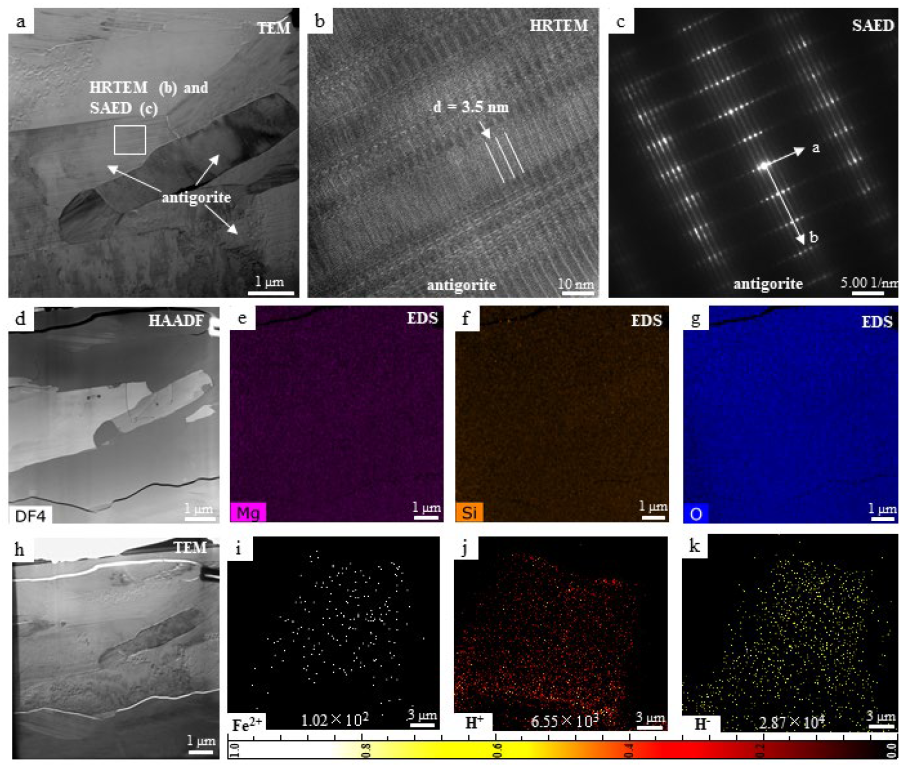
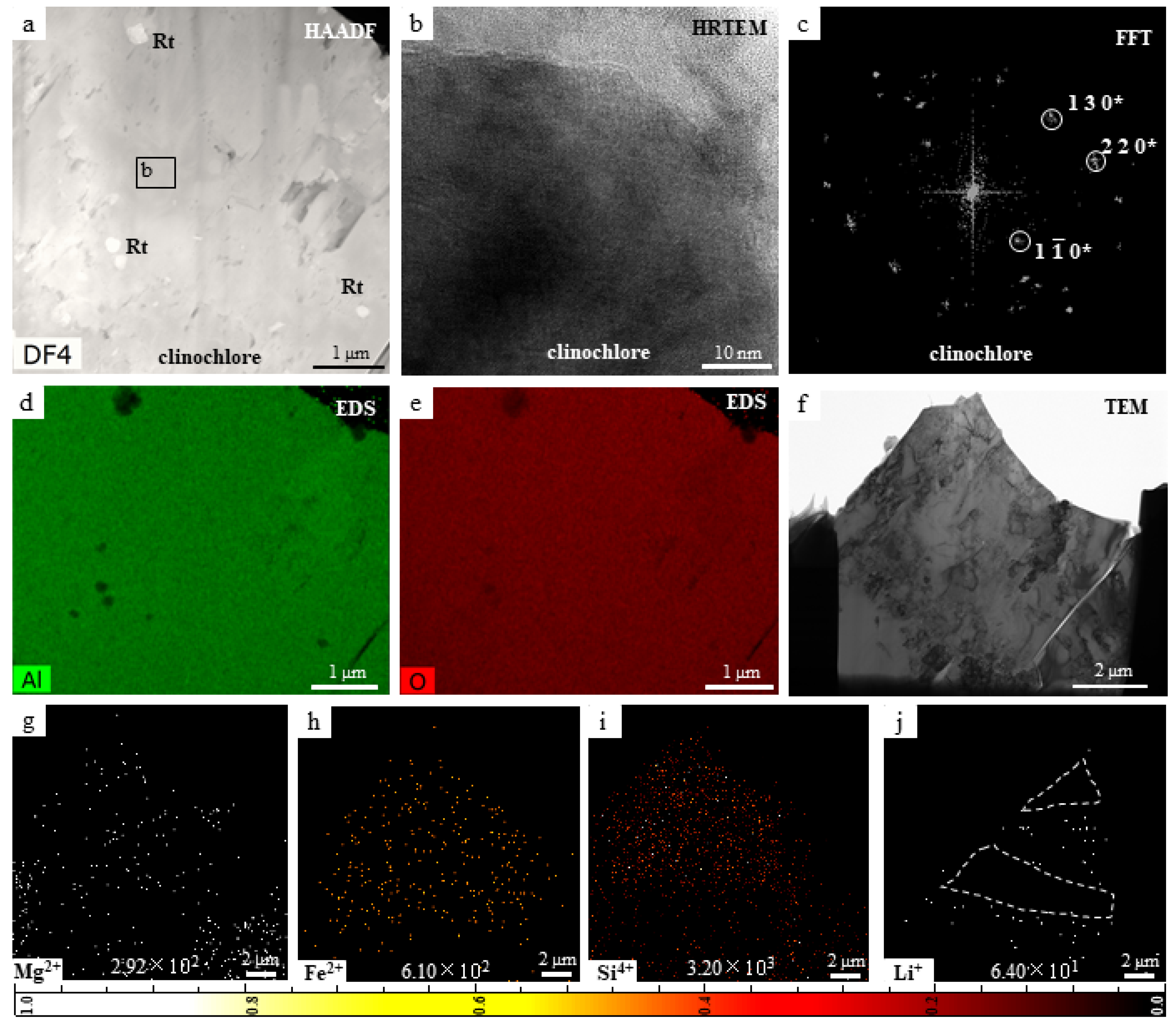
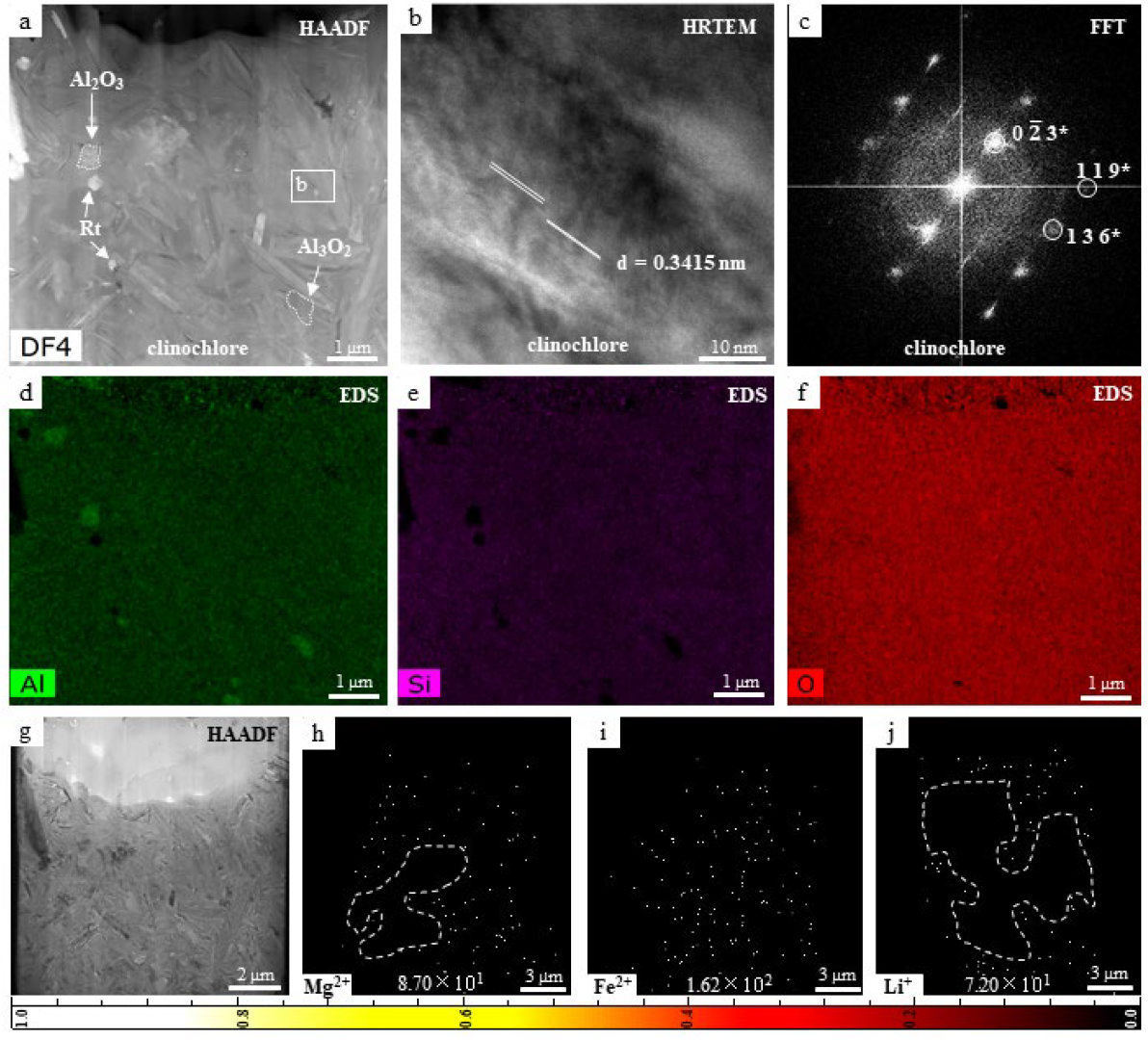
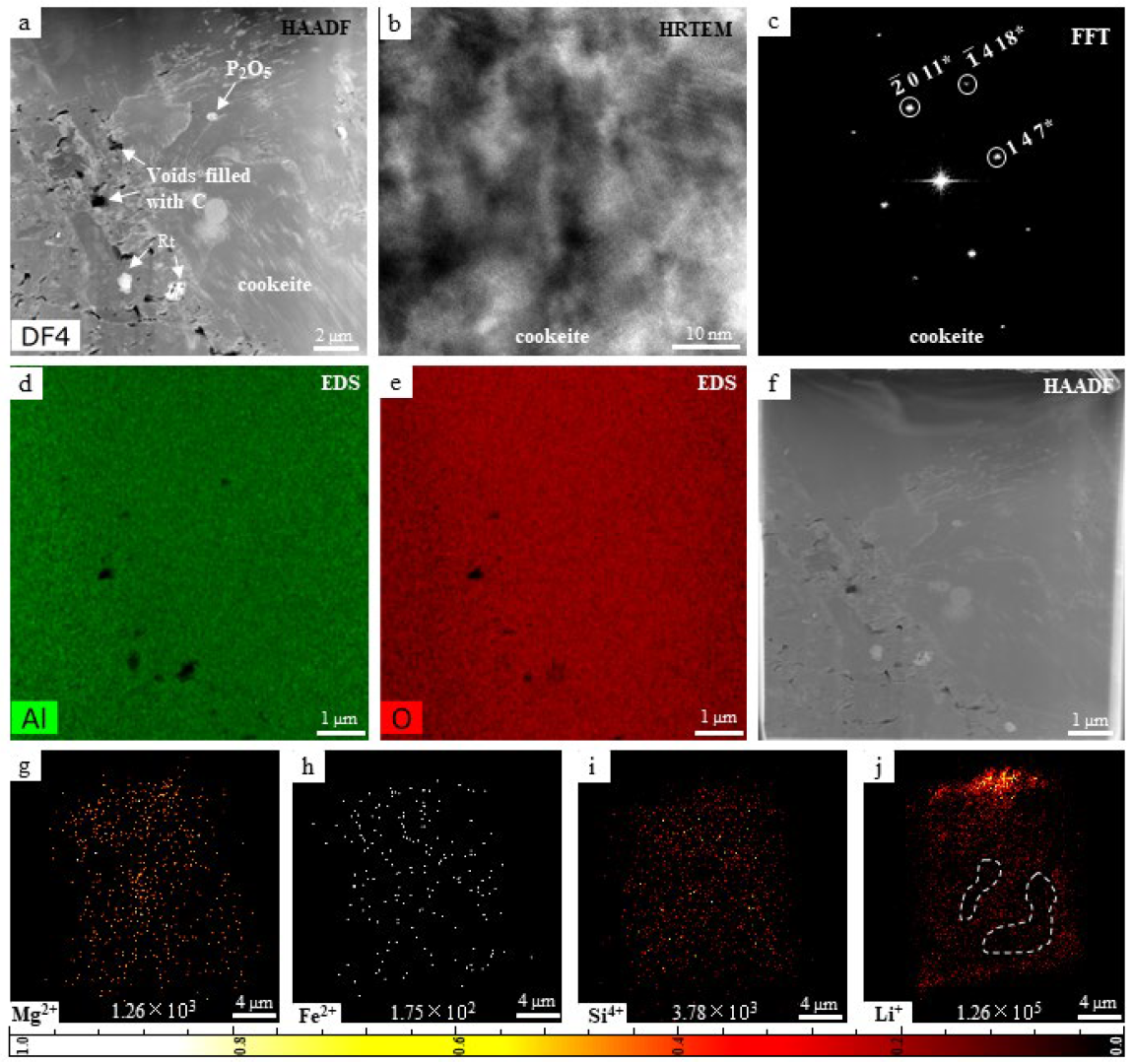
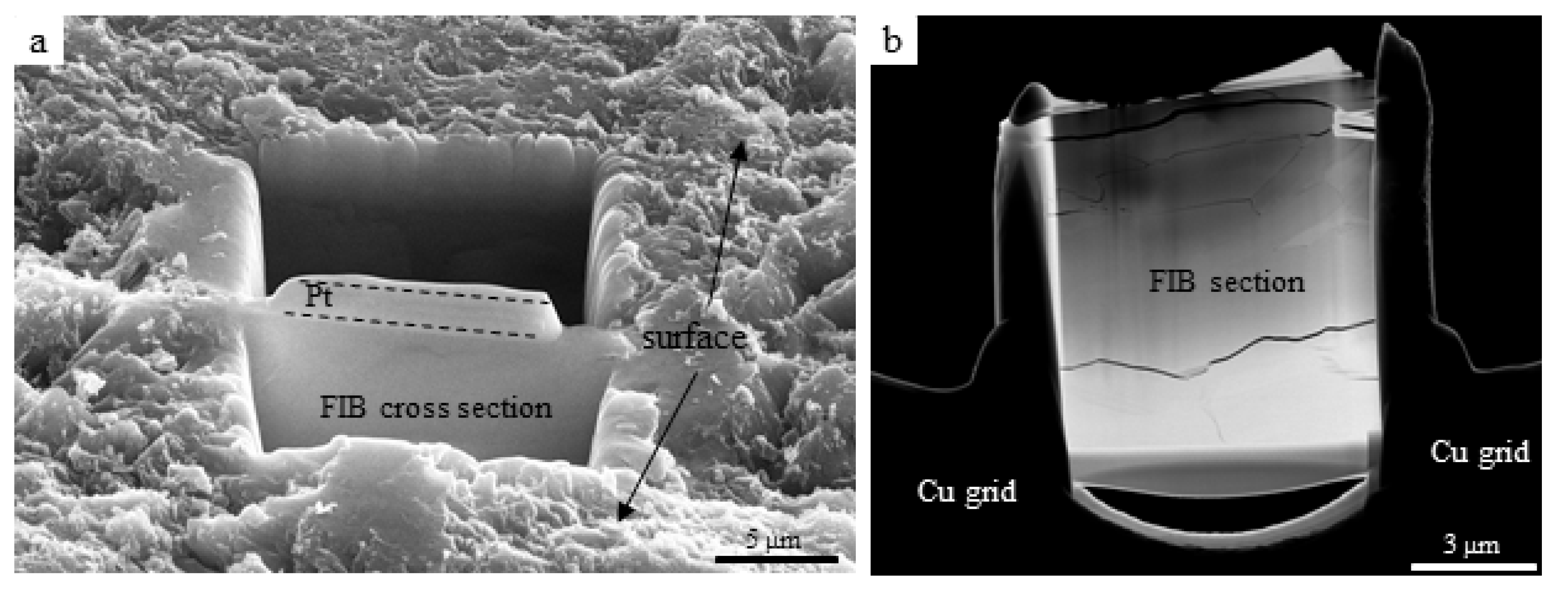
Publisher’s Note: MDPI stays neutral with regard to jurisdictional claims in published maps and institutional affiliations. |
© 2022 by the authors. Licensee MDPI, Basel, Switzerland. This article is an open access article distributed under the terms and conditions of the Creative Commons Attribution (CC BY) license (https://creativecommons.org/licenses/by/4.0/).
Share and Cite
Tai, K.; Li, Y.; Liu, S.; Guo, Z.; Li, C.; Du, L.; Zhao, S.; Li, X.; Liu, J. In Situ FIB-TEM-TOF-SIMS Combination Technique: Application in the Analysis of Ultra-Light and Trace Elements in Phyllosilicates. Minerals 2022, 12, 562. https://doi.org/10.3390/min12050562
Tai K, Li Y, Liu S, Guo Z, Li C, Du L, Zhao S, Li X, Liu J. In Situ FIB-TEM-TOF-SIMS Combination Technique: Application in the Analysis of Ultra-Light and Trace Elements in Phyllosilicates. Minerals. 2022; 12(5):562. https://doi.org/10.3390/min12050562
Chicago/Turabian StyleTai, Kairui, Yang Li, Shen Liu, Zhuang Guo, Chen Li, Lin Du, Sizhe Zhao, Xiongyao Li, and Jianzhong Liu. 2022. "In Situ FIB-TEM-TOF-SIMS Combination Technique: Application in the Analysis of Ultra-Light and Trace Elements in Phyllosilicates" Minerals 12, no. 5: 562. https://doi.org/10.3390/min12050562
APA StyleTai, K., Li, Y., Liu, S., Guo, Z., Li, C., Du, L., Zhao, S., Li, X., & Liu, J. (2022). In Situ FIB-TEM-TOF-SIMS Combination Technique: Application in the Analysis of Ultra-Light and Trace Elements in Phyllosilicates. Minerals, 12(5), 562. https://doi.org/10.3390/min12050562





